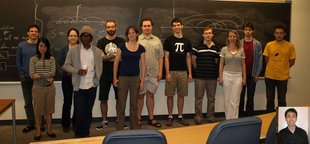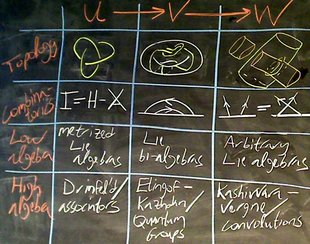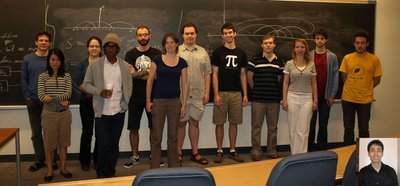|
|
| Line 1: |
Line 1: |
|
{{AKT-09/Navigation}} |
|
{{AKT-09/Navigation}} |
|
{{In Preparation}} |
|
|
|
|
|
|
'''Solve the following problems''' and submit them in class by October 13, 2006: |
|
'''Solve the following problems''' and submit them in class by October 13, 2006: |
| Line 10: |
Line 9: |
|
{{Equation*|<math>P = \sum_{n=0}^\infty \frac{(-\Theta)^n}{n!}\partial_\theta^n.</math>}} |
|
{{Equation*|<math>P = \sum_{n=0}^\infty \frac{(-\Theta)^n}{n!}\partial_\theta^n.</math>}} |
|
|
|
|
|
The following assertions can be verified:
|
|
Verify the following assertions, but submit only your work on assertions 4,5,7,11: |
|
|
|
|
|
# <math>\left[\partial_\theta,\Theta\right]=1</math>, where <math>1:{\mathcal A}\to{\mathcal A}</math> is the identity map and where <math>[A,B]:=AB-BA</math> for any two operators. |
|
# <math>\left[\partial_\theta,\Theta\right]=1</math>, where <math>1:{\mathcal A}\to{\mathcal A}</math> is the identity map and where <math>[A,B]:=AB-BA</math> for any two operators. |
| Line 16: |
Line 15: |
|
# <math>\partial_\theta</math> satisfies Leibnitz' law: <math>\partial_\theta(ab)=(\partial_\theta a)b+a(\partial_\theta b)</math> for any <math>a,b\in{\mathcal A}</math>. |
|
# <math>\partial_\theta</math> satisfies Leibnitz' law: <math>\partial_\theta(ab)=(\partial_\theta a)b+a(\partial_\theta b)</math> for any <math>a,b\in{\mathcal A}</math>. |
|
# <math>P</math> is an algebra morphism: <math>P1=1</math> and <math>P(ab)=(Pa)(Pb)</math>. |
|
# <math>P</math> is an algebra morphism: <math>P1=1</math> and <math>P(ab)=(Pa)(Pb)</math>. |
|
# <math>\Theta</math> satisfies the co-Leibnitz law: <math>\Box\circ\Theta=(\Theta\otimes 1+1\otimes\Theta)\circ\Box</math> (why does this deserve the name ``the co-Leibnitz law''?). |
|
# <math>\Theta</math> satisfies the co-Leibnitz law: <math>\Box\circ\Theta=(\Theta\otimes 1+1\otimes\Theta)\circ\Box</math> (why does this deserve the name "the co-Leibnitz law"?). |
|
# <math>P</math> is a co-algebra morphism: <math>\eta\circ P=\eta</math> (where <math>\eta</math> is the co-unit of <math>{\mathcal A}</math>) and <math>\Box\circ P=(P\otimes P)\circ\Box</math>. |
|
# <math>P</math> is a co-algebra morphism: <math>\eta\circ P=\eta</math> (where <math>\eta</math> is the co-unit of <math>{\mathcal A}</math>) and <math>\Box\circ P=(P\otimes P)\circ\Box</math>. |
|
# <math>P\theta=0</math> and hence <math>P\langle\theta\rangle=0</math>, where <math>\langle\theta\rangle</math> is the ideal generated by <math>\theta</math> in the algebra <math>{\mathcal A}</math>. |
|
# <math>P\theta=0</math> and hence <math>P\langle\theta\rangle=0</math>, where <math>\langle\theta\rangle</math> is the ideal generated by <math>\theta</math> in the algebra <math>{\mathcal A}</math>. |
|
# If <math>Q:{\mathcal A}\to{\mathcal A}</math> is defined by {{Equation*|<math>Q = \sum_{n=0}^\infty \frac{(-\Theta)^n}{(n+1)!}\partial_\theta^{(n+1)}</math>}} then <math>a=\theta Qa+Pa</math> for all <math>a\in{\mathcal A}</math>. |
|
# If <math>Q:{\mathcal A}\to{\mathcal A}</math> is defined by {{Equation*|<math>Q = \sum_{n=0}^\infty \frac{(-\Theta)^n}{(n+1)!}\partial_\theta^{(n+1)}</math>}} then <math>a=\theta Qa+Pa</math> for all <math>a\in{\mathcal A}</math>. |
|
# <math>\ker P=\langle\theta\rangle</math>. |
|
# <math>\ker P=\langle\theta\rangle</math>. |
|
# <math>P</math> descends to a Hopf algebra morphism <math>{\mathcal A}^r\to{\mathcal A}</math>, and if <math>\pi:{\mathcal A}\to{\mathcal A}^r</math> is the obvious projection, then <math>\pi\circ P</math> is the identity of <math>{\mathcal A}^r</math>. (Recall that <math>{\mathcal A}^r={\mathcal A}/\langle\theta\rangle</math>.) |
|
# <math>P</math> descends to a Hopf algebra morphism <math>{\mathcal A}^r\to{\mathcal A}</math>, and if <math>\pi:{\mathcal A}\to{\mathcal A}^r</math> is the obvious projection, then <math>\pi\circ P</math> is the identity of <math>{\mathcal A}^r</math>. (Recall that <math>{\mathcal A}^r={\mathcal A}/\langle\theta\rangle</math>). |
|
# <math>P^2=P</math>. |
|
# <math>P^2=P</math>. |
|
|
|
|
| #
|
Week of...
|
Videos, Notes, and Links
|
| 1
|
Sep 7
|
About This Class
 090910-1: 3-colourings, Reidemeister's theorem, invariance, the Kauffman bracket. 090910-1: 3-colourings, Reidemeister's theorem, invariance, the Kauffman bracket.
 090910-2: R23 invariance of the bracket, R1, the writhe, the Jones polynomial, programming the Jones polynomial. 090910-2: R23 invariance of the bracket, R1, the writhe, the Jones polynomial, programming the Jones polynomial.
Tricolourability
|
| 2
|
Sep 14
|
 090915: More on Jones, some pathologies and more on Reidemeister, our overall agenda. 090915: More on Jones, some pathologies and more on Reidemeister, our overall agenda.
 090917-1: The definition of finite type, weight systems, Jones is a finite type series. 090917-1: The definition of finite type, weight systems, Jones is a finite type series.
 090917-2: The skein relation for Jones; HOMFLY-PT and Conway; the weight system of Jones. 090917-2: The skein relation for Jones; HOMFLY-PT and Conway; the weight system of Jones.
|
| 3
|
Sep 21
|
 090922: FI, 4T, HOMFLY and FI and 4T, statement of the Fundamental Theorem, framed knots. 090922: FI, 4T, HOMFLY and FI and 4T, statement of the Fundamental Theorem, framed knots.
 090924-1: Some dimensions of 090924-1: Some dimensions of  , ,  is a commutative algebra, is a commutative algebra,  . .
Class Photo
 090924-2: 090924-2:  is a co-commutative algebra, the relation with products of invariants, is a co-commutative algebra, the relation with products of invariants,  is a bi-algebra. is a bi-algebra.
|
| 4
|
Sep 28
|
Homework Assignment 1
Homework Assignment 1 Solutions
 090929: The Milnor-Moore theorem, primitives, the map 090929: The Milnor-Moore theorem, primitives, the map  . .
 091001-1: Jacobi diagrams, AS, IHX, STU, and the equivalence of all that with 4T. 091001-1: Jacobi diagrams, AS, IHX, STU, and the equivalence of all that with 4T.
 091001-2: The very basics on Lie algebras. 091001-2: The very basics on Lie algebras.
|
| 5
|
Oct 5
|
 091006: Lie algebraic weight systems, 091006: Lie algebraic weight systems,  . .
 091008-1: More on 091008-1: More on  , Lie algebras and the four colour theorem. , Lie algebras and the four colour theorem.
 091008-2: The "abstract tenssor" approach to weight systems, 091008-2: The "abstract tenssor" approach to weight systems,  and PBW, the map and PBW, the map  . .
|
| 6
|
Oct 12
|
 091013: Algebraic properties of 091013: Algebraic properties of  vs. algebraic properties of vs. algebraic properties of  . .
Thursday's class canceled.
|
| 7
|
Oct 19
|
 091020: Universal finite type invariants, filtered and graded spaces, expansions. 091020: Universal finite type invariants, filtered and graded spaces, expansions.
Homework Assignment 2
The Stonehenge Story
 091022-1: The Stonehenge Story to IHX and STU. 091022-1: The Stonehenge Story to IHX and STU.
 091022-2: The Stonhenge Story: anomalies, framings, relation with physics. 091022-2: The Stonhenge Story: anomalies, framings, relation with physics.
|
| 8
|
Oct 26
|
 091027: Knotted trivalent graphs and their chord diagrams. 091027: Knotted trivalent graphs and their chord diagrams.
 091029-1: Zsuzsi Dancso on the Kontsevich Integral (1). 091029-1: Zsuzsi Dancso on the Kontsevich Integral (1).
 091029-2: Zsuzsi Dancso on the Kontsevich Integral (2). 091029-2: Zsuzsi Dancso on the Kontsevich Integral (2).
|
| 9
|
Nov 2
|
 091103: The details of 091103: The details of  . .
 091105-1: Three basic problems: genus, unknotting numbers, ribbon knots. 091105-1: Three basic problems: genus, unknotting numbers, ribbon knots.
 091105-2: The three basic problems and algebraic knot theory. 091105-2: The three basic problems and algebraic knot theory.
|
| 10
|
Nov 9
|
 091110: Tangles and planar algebras, shielding and the generators of KTG. 091110: Tangles and planar algebras, shielding and the generators of KTG.
Homework Assignment 3
No Thursday class.
|
| 11
|
Nov 16
|
Local Khovanov Homology
 091119-1: Local Khovanov homology, I. 091119-1: Local Khovanov homology, I.
 091119-2: Local Khovanov homology, II. 091119-2: Local Khovanov homology, II.
|
| 12
|
Nov 23
|
 091124: Emulation of one structure inside another, deriving the pentagon. 091124: Emulation of one structure inside another, deriving the pentagon.
 091126-1: Peter Lee on braided monoidal categories, I. 091126-1: Peter Lee on braided monoidal categories, I.
 091126-2: Peter Lee on braided monoidal categories, II. 091126-2: Peter Lee on braided monoidal categories, II.
|
| 13
|
Nov 30
|
 091201: The relations in KTG. 091201: The relations in KTG.
 091203-1: The Existence of the Exponential Function. 091203-1: The Existence of the Exponential Function.
 091203-2: The Final Exam, Dror's failures. 091203-2: The Final Exam, Dror's failures.
|
| F
|
Dec 7
|
The Final Exam on Thu Dec 10, 9-11, Bahen 6183.
|
| Register of Good Deeds / To Do List
|

Add your name / see who's in!
|

|
|
Solve the following problems and submit them in class by October 13, 2006:
Problem 1. If  and
and  then
then  (as what one would expect by looking at degrees of polynomials) and
(as what one would expect by looking at degrees of polynomials) and  where
where  and
and  is the multiplication of rationals. (See 090924-2, minute 36:01).
is the multiplication of rationals. (See 090924-2, minute 36:01).
Problem 2. Let  be the multiplication operator by the 1-chord diagram
be the multiplication operator by the 1-chord diagram  , and let
, and let  be the adjoint of multiplication by
be the adjoint of multiplication by  on
on  , where
, where  is the obvious dual of
is the obvious dual of  in
in  . Let
. Let  be defined by
be defined by

Verify the following assertions, but submit only your work on assertions 4,5,7,11:
![{\displaystyle \left[\partial _{\theta },\Theta \right]=1}](https://wikimedia.org/api/rest_v1/media/math/render/svg/17a787765f92be6a78ef25b1c73d5dc6895f2e6e) , where
, where  is the identity map and where
is the identity map and where ![{\displaystyle [A,B]:=AB-BA}](https://wikimedia.org/api/rest_v1/media/math/render/svg/863994f9f066fdc4ae4679dd7aad6dc461724a90) for any two operators.
for any two operators. is a degree
is a degree  operator; that is,
operator; that is,  for all
for all  .
. satisfies Leibnitz' law:
satisfies Leibnitz' law:  for any
for any  .
. is an algebra morphism:
is an algebra morphism:  and
and  .
. satisfies the co-Leibnitz law:
satisfies the co-Leibnitz law:  (why does this deserve the name "the co-Leibnitz law"?).
(why does this deserve the name "the co-Leibnitz law"?). is a co-algebra morphism:
is a co-algebra morphism:  (where
(where  is the co-unit of
is the co-unit of  ) and
) and  .
. and hence
and hence  , where
, where  is the ideal generated by
is the ideal generated by  in the algebra
in the algebra  .
.- If
 is defined by
is defined by  then
then  for all
for all  .
.
 .
. descends to a Hopf algebra morphism
descends to a Hopf algebra morphism  , and if
, and if  is the obvious projection, then
is the obvious projection, then  is the identity of
is the identity of  . (Recall that
. (Recall that  ).
). .
.
Mandatory but unenforced. Find yourself in the class photo and identify yourself as explained in the photo page.























![{\displaystyle \left[\partial _{\theta },\Theta \right]=1}](https://wikimedia.org/api/rest_v1/media/math/render/svg/17a787765f92be6a78ef25b1c73d5dc6895f2e6e)

![{\displaystyle [A,B]:=AB-BA}](https://wikimedia.org/api/rest_v1/media/math/render/svg/863994f9f066fdc4ae4679dd7aad6dc461724a90)


























